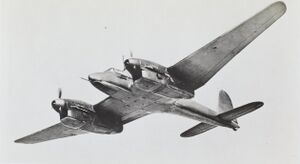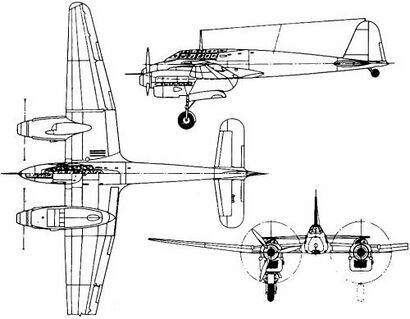Devati 191
| Devati 191 | |
|---|---|

| |
| Role | Fighter Fighter-Bomber |
| National origin | Tennai |
| Manufacturer | Devati |
| Designer | Kanira Velamuri |
| First flight | February 1936 |
| Introduction | July 1936 |
| Retired | 1949 |
| Status | Retired |
| Primary user | Royal Tennaiite Air Force |
| Produced | 1936-1947 |
| Number built | 7,637 |
The Devat 191 was a Tennaiite aircraft developed in the late 1930s. It was conceived by Kanira Velamuri as a twin-engine, high-performance fighter, but it proved a versatile platform and was developed into fighter-bomber and aerial reconnaissance versions as well. The Devati 191 and its variants served on all fronts of the Siduri War. The Dv 191 continued to serve in the Royal Tennaiite Air Force until 1949.
Design and Development
In the early to mid-1930s, developments in airframe design outstripped available aircraft engine power, allowing large aircraft to be built that existing engines were unable to sufficiently lift or propel (at least not alone). A period ensued in which multi-engine designs mostly outperformed aircraft designed with just one engine. It was durning this period in early 1934, shortly before the outbreak of the Siduri War in Tennai, that the Tennaiite Royal Air Force tendered a request for a high-speed and long range fighter aircraft that could be used as a bomber escort and patrol aircraft.
In 1934, Kanira Velamuri began design work a long-range single-seat fighter under a private venture within Devati. The idea was not to produce a heavy fighter or bomber destroyer, but instead a long-range design that would have the performance of a single-seat design. Powered by the new 736 kW (1,000 PS) Devati S-P251-112 Deva, it had an expected speed of 560 km/h (350 mph). The design was unveiled in 1935 at an exhibition of new weapons, prototypes and projects held at the Devati factory at Kalatta, where it was viewed by a number of high-ranking Tennaiite officials, including Queen Nimeeka II. The Tennaiite Air Ministry showed great interest in the design and offered Devati a contract to further develop the aircraft with a request for prototypes as soon as Devati could provide them. The Siduri War was ongoing and the need for the aircraft was greater than ever.
The original design made accommodations for four Basu HV 80 7.62 caliber machine guns with 400 rpg and two Basu FG 20-20 cannons with 100 rpg. Uncommon for many fighters of the era who mounted much of thier weaponry in the wings, the Dv 191s weapon were clustered in the fuselage of the aircraft. Wing-mounted guns were set up with tractectories set up to crisscross at one or more points in a convergence zone. By contrasts, the fuselage-mounted guns of the Dv 190 did not suffer from having thier useful range limited by pattern convergence, meaning that good pilots could shoot much farther. A Dv 190 could reliably hit targets at any range up to 910 m (1,000 yd), whereas the wing guns of other fighters were optimized for specific range.
Prototypes
The engine nacelles were relatively normal, including both the engine and the main landing gear storage, but the front-mounted radiators for the engines were retractable for high speed when less frontal area would be needed to get the same airflow (an idea which was in some vogue at the time). The mainwheels were fully retractable and faired and the design of the wing and tailplane required no struts or supports (unlike some late 1930s designs), in order to further reduce drag. The wing's two spars passed under the pilot's seat. As was common on pre-war designs, the line of the rear fuselage flowed straight into the line of the canopy, which created less drag than a bubble canopy (though a bubble canopy was adopted on later variants), but also blocked direct viewing to the rear, although there were cutouts in the rear fuselage and the rear section of the canopy, which opened rearward and upward at an angle of about 15°, extended some ways to the rear to provide a degree of vision over the pilot's shoulder, if not directly rearward (the forward section of the canopy, over the pilot himself, hinged forwards in an unusual fashion). Although the cockpit was located well forward, a small window panel was fitted in the underside of the nose by the pilot's feet to improve the view for landing.
The first prototype, Dv 191 V1 , flew for the first time in February 1936, with Thakshara Neela at its controls. In testing it demonstrated a speed of 565 km/h (351 mph), 80 km/h (50 mph) faster than the contemporary single engine Cheppali Cp 117, despite having twice the range, more than twice the weight, and using two of the same engines. Members of the Tennaiite Air Ministry were again impressed by the aircraft and placed an order for an initial batch of 250 aircraft, despite the need for design modifications.
Several changes were made to the design as a result of the testing, including new DVL propellers in place of the original Chandra-Seeth, and experimental twin-wheel bogies that were abandoned after testing. The designers were concerned about flutter in the rudder at high speed and had a weight fitted to reduce it but in testing this caused so much flutter it was torn off at high speed. A second prototype followed with fixed radiators rather than earlier retractable versions, a semi-retractable tailwheel, changes to the elevator, and a vertical stabilizer with reduced chord. The engine was also upgraded to the S-P251-116 version of the Deva, featuring direct fuel injection which resulted in a significant increase in power. New ejector-type exhaust stacks also contributed to increased speed by directing engine exhaust to the rear. Dv 191 V2 started testing in May of 1936, but crashed on landing when part of the main landing gear failed, and V1 was destroyed on 2 June 1936 after a high-speed pass over the Koldari facilities when the pilot, Nilaa Bamala, pulled up too sharply at the end of the pass resulting in a stall that sent the aircraft spinning into the ground. At the time of the V2 crash, Dv 191 V3 was 90% complete. V3 commenced flight testing on 15 June 1936 and following successful flight testing over the next month, the Dv 191 began serial production on 17 July 1936.
Operational Service
Variants
- A-Series
- First production variant with 7.62mm machine guns and mounting the 986 hp Devati S-P251-112 Deva engine
- B-Series
- The four 7.62 machine guns were replaced with four 12.7 mm machine guns, mounting of the 1,159 hp S-P252-112 Deva engine, addition of cabin pressurization, hardpoints for drop tanks added
- C-Series
- Redesign which added a bubble canopy and the mounting of the 1,430 hp S-P252-115 Deva engine
- D-Series
- As Reconnaissance variant, Same as the C-series except with the guns removed and replaced with photography equipment
- E-Series
- Mounting the 1,600 hp S-P253-113 Deva engine, incorporating improved cabin pressurization, redesigned streamlined engine nacelles for lower drag
- F-Series
- Figter-Bomber Variant, added harpoints for bombs and rockets
- G-series through K-Series
- Incremental upgrades of aircraft systems to keep aircraft competitive
Operators
Surving Aircraft
Specifications Dv 191 K3
General characteristics
- Crew: 1
- Length: 11.1 m (36 ft 5 in)
- Wingspan: 15.3 m (50 ft 2 in)
- Height: 3.85 m (12 ft 8 in)
- Wing area: 30.4 m2 (327 sq ft)
- Empty weight: 3,600 kg (7,937 lb)
- Gross weight: 5,000 kg (11,023 lb)
- Max takeoff weight: 5,950 kg (13,118 lb)
- Powerplant: 2 × Devati S-P253-117 Deva V-12 inverted liquid-cooled piston engines 1,622 PS (1,193 kW; 1,600 hp)
- Propellers: 3-bladed light-alloy constant-speed propellers
Performance
- Maximum speed: 684 km/h (425 mph; 369 kn) at 9,144 m (30,000 ft)
- Cruise speed: 501 km/h (311 mph; 271 kn)
- Stall speed: 105 km/h (65 mph; 57 kn)
- Combat range: 2,100 km (1,305 mi; 1,134 nmi)
- Ferry range: 5,300 km (3,293 mi; 2,862 nmi)
- Service ceiling: 13,000 m (43,000 ft)
- Rate of climb: 25 m/s (4,900 ft/min)
- Time to altitude: 6,000 m (19,685 ft) in 5 minutes 12 seconds
Armament
- Guns:
- 4 × 12.72 mm (0.501 in) Basu HV 82 machine guns in fuselage sides
- 2 × 20 mm (0.787 in) Basu FG 20-20 cannon in lower fuselage
- 4× M10 three-tube 4.5 in (112 mm) Hornet 7 rocket launchers; or:
- Inner hardpoints:
- 2× 2,000 lb (907 kg) bombs or drop tanks; or
- 2× 1,000 lb (454 kg) bombs or drop tanks, plus either
- 4× 500 lb (227 kg) bombs or
- 4× 250 lb (113 kg) bombs; or
- 6× 500 lb (227 kg) bombs; or
- 6× 250 lb (113 kg) bombs
- Outer hardpoints:
- 10× 5 in (127 mm) HVARs (High Velocity Aircraft Rockets); or
- 2× 500 lb (227 kg) bombs; or
- 2× 250 lb (113 kg) bombs
- Inner hardpoints:
